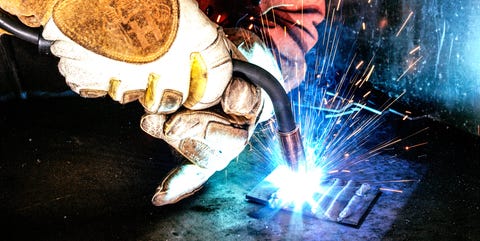I can divide my life into two distinct segments: the time before I owned a welder, and every day since. When I bought my first truck, a 20-year-old Tacoma with a rusty frame, my welder made it roadworthy. When I started my blacksmith business out of my grandparents' garage, I used my welder to build a forge out of scrap metal. And when a neighbor needs a railing fixed, it's my welder he wants me to use to fix it—usually for free.
My great-grandfather was the first welder in my family. He started out running a welding shop, and later, during World War II, a school named Wicks Welding in Queens, New York. In his day welding required a complicated setup of machines and gas tanks that looked like they belonged on the set of a bad sci-fi movie. While the usefulness of welders hasn't changed a lot since then, the technology has. Now welders are accessible to anyone, regardless of skill, and you don't have to break your back or the bank to use one.
We tested eight of the best new entry-level welders. They can be plugged into a normal electrical outlet and run without any gas tanks using a process called flux-cored arc welding (see opposite). And when you're ready to buy some tanks, they can also be run as MIG welders. These four were our favorites
Buy Now
LIKES: Harbor Freight's new line stands against the best welders available. Sturdy construction, easy-to-use automatic settings, and a wide range of applications.
DISLIKES: As a new product, there's no history of performance.
$500
Buy Now
LIKES: Great power and a well-earned reputation for top performance makes Miller a sure bet. Heavy-duty and able to handle a wide range of projects.
DISLIKES: Expensive, and set up more for MIG welding than flux.
$79
Buy Now
LIKES: Great welding arc, especially on thicker steel, combined with a useful EZ-Mode with automatic settings, means a consistently stress-free experience. More compact than the competition and a good price point.
DISLIKES: Limited accessories, such as extra welding wire or gas gauges (for those looking to also run MIG) compared to the competition.
$400
Buy Now
LIKES: Using this machine felt like welding with a paintbrush. It's smooth, powerful, easy to use, and reasonably priced. You might be tempted to get Lincoln's 125HD and save $100, but don't. The 140 lets you work thicker materials, and can also be used for MIG welding.
DISLIKES: Not as heavy-duty as the Miller or Vulcan, so better left in the shop than taken to the job site.
$524
5
The More Advanced Choice: Vulcan OmniPro 220
Buy Now
For more advanced welders, the Vulcan OmniPro 220 ($800) does flux-cored and MIG welding, along with stick electrode and tungsten electrode and filler rod (TIG). It's versatile and powerful, and it works at 120 and 240 volts. To test it, we took it to JJ Cunningham & Sons in Bristol, Pennsylvania. Mike Cunningham ran the OmniPro with flux-cored wire and a variety of stick electrodes. His take: "Anybody can weld with this thing." You use an LCD screen and dials to set the welding mode. I wondered if Mike had exaggerated the "anybody" part, so I tried my hand with a stick electrode, a first for me, and pulled a neat bead. I guess he was right.
6
What is flux-cored arc welding?
Any welding consists of melting base metals and then usually adding a filler material to join them. Think of it like a glue gun, but thousands of degrees hotter. In most cases, the metal is melted using an electrical arc, like in spark plugs. This arc is created by passing electricity from the tip, or electrode, of the welder to the metal you are working in order to melt the material and create the weld. When steel and other metals are in a liquid state, however, they become very reactive to air and can become brittle and useless. Special shielding gases are usually needed to prevent this mixing from happening. In flux-cored arc welding, however, a shielding "flux" in the core of the wire evaporates during welding to automatically protect the weld
